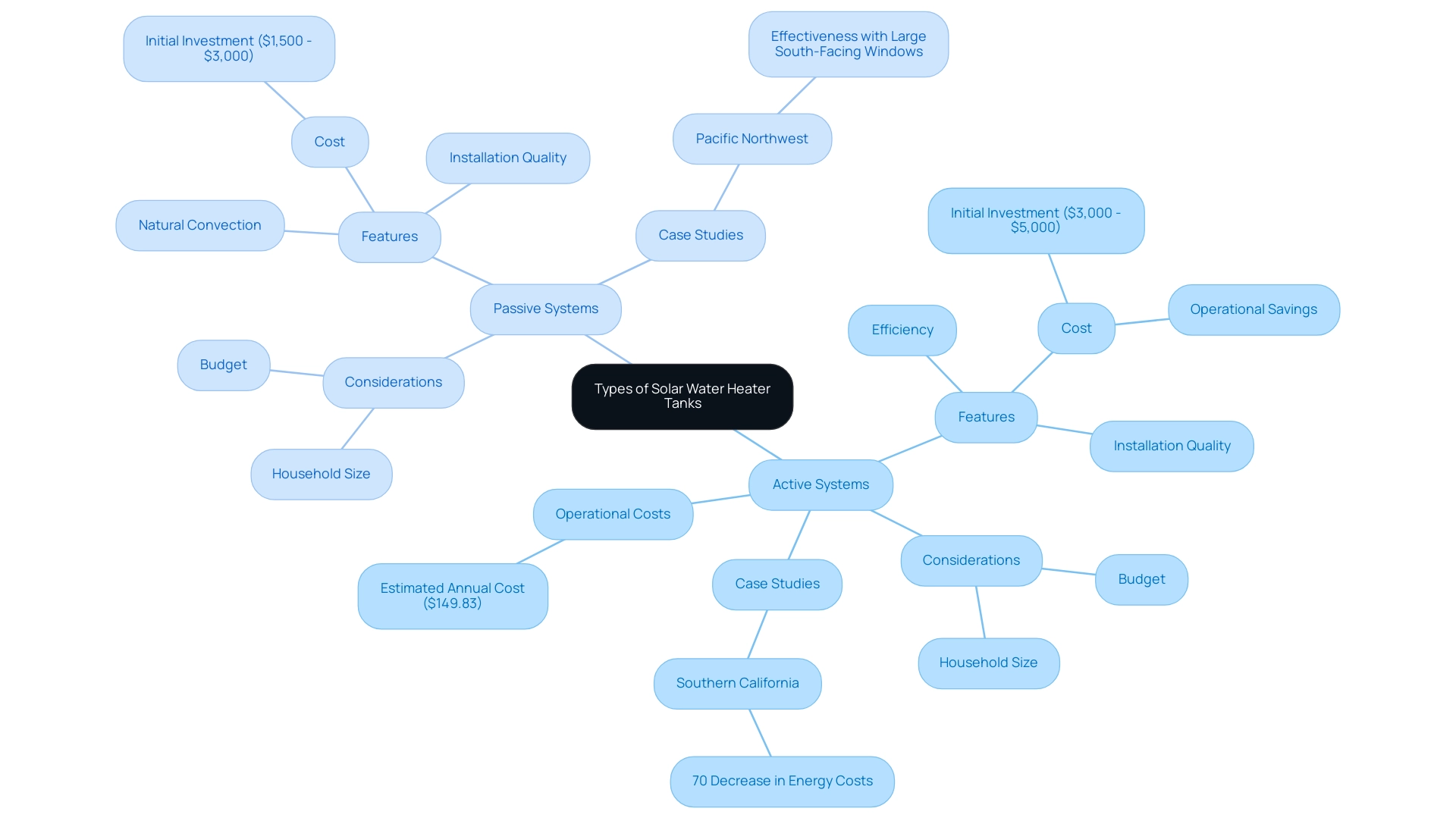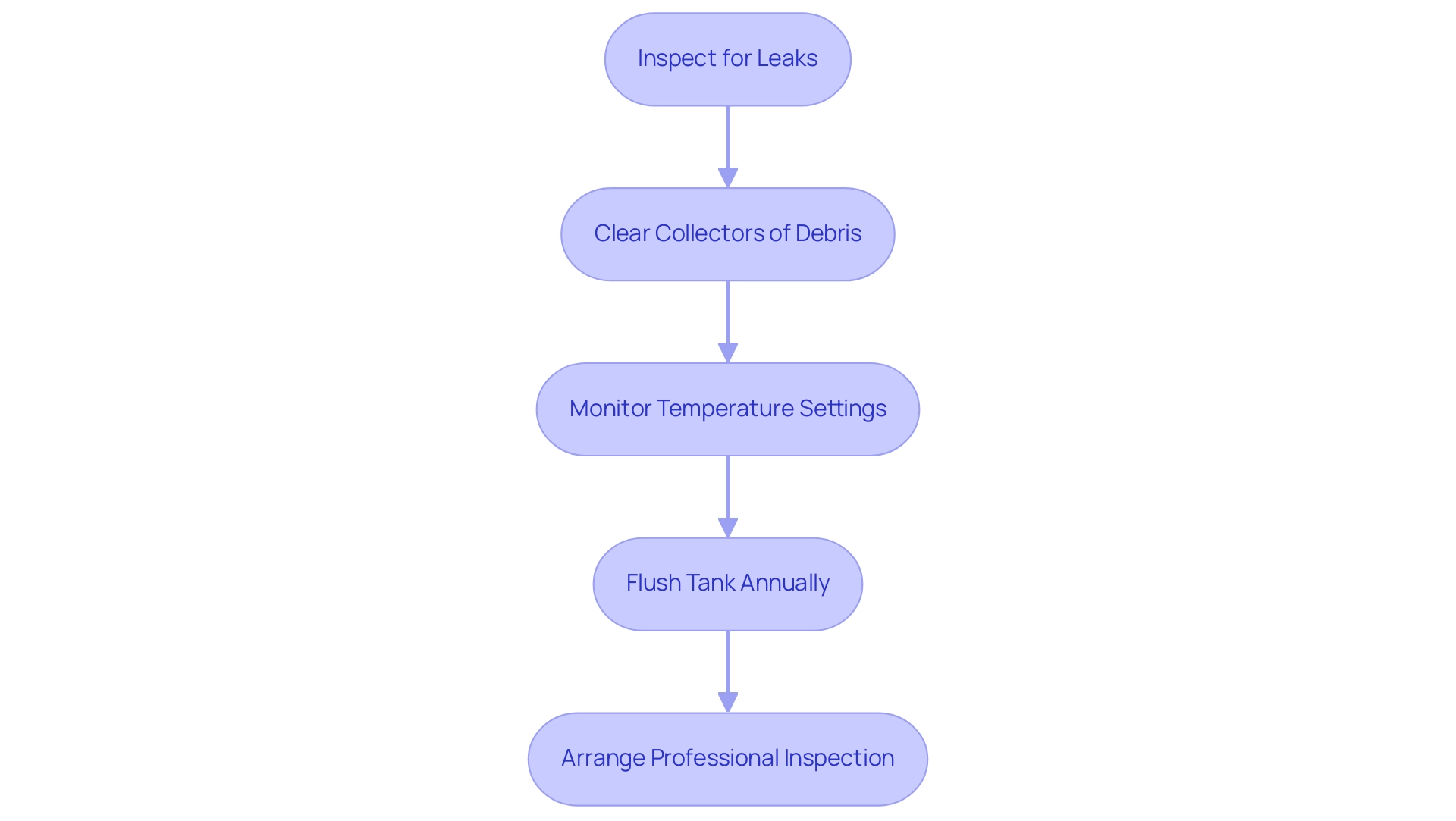Overview
Solar water heater tanks are specialized storage units designed to hold heated liquid generated from sunlight, playing a crucial role in thermal heating systems for household applications like bathing and cooking. The article emphasizes the importance of understanding their functionality, types (active and passive), and maintenance needs to optimize energy efficiency and promote sustainable living practices, highlighting significant cost savings and environmental benefits for homeowners.
Introduction
The growing interest in sustainable living has led many homeowners to explore innovative solutions for energy efficiency, and solar water heater tanks are at the forefront of this movement. These tanks play a vital role in harnessing solar energy to provide hot water for everyday needs, from showers to dishwashing. With the ability to significantly reduce utility bills and promote a greener lifestyle, understanding the intricacies of solar water heater tanks is essential for anyone considering this eco-friendly option.
This article delves into the various types of solar water heater tanks available, how they function within heating systems, their numerous benefits, and crucial maintenance tips to ensure longevity and optimal performance. By equipping homeowners with the right knowledge, it becomes easier to make informed decisions that not only enhance comfort but also contribute to a sustainable future.
Understanding Solar Water Heater Tanks: An Overview
Solar water heater tanks are essential elements of thermal heating systems, specifically created to store the heated liquid produced from sunlight. These tanks, known as solar water heater tanks, function in harmony with collectors that capture sunlight and convert it into heat. Once heated, the liquid is stored in solar water heater tanks, making it ready for various household uses such as bathing, cooking, and cleaning.
This combination not only offers convenience but is also central to promoting energy-efficient and sustainable living practices. When choosing a solar heating device, it’s vital to evaluate your household size and hot supply requirements, ensuring it has the appropriate capacity. Furthermore, the First Hour Rating (FHR) is a significant performance metric to evaluate, as it gauges the volume of hot liquid a device can provide in the initial hour of operation.
A setup with a high FHR might be more efficient for households with high hot liquid demand. With the thermal energy market in the GCC anticipated to expand at a CAGR of 6.5%, achieving a market size of USD 24.41 million in 2024, it’s evident that these units are becoming progressively vital for environmentally aware homeowners. As one expert aptly put it, ‘You’re racing against time to analyze data,’ underlining the need to stay informed about advancements in this field.
By understanding the structure and function of solar water heater tanks, as well as the importance of installation ease and maintenance, homeowners can truly appreciate how these tanks reduce energy consumption, promote a greener lifestyle, and contribute to cost savings while addressing environmental concerns.
Types of Solar Water Heater Tanks: Choosing the Right One for Your Needs
When it comes to solar water heater tanks, you’ll typically encounter two primary types: active and passive. Active setups are outfitted with pumps and controls that circulate liquid, leading to more efficient heating and quicker delivery of hot fluid. On the other hand, passive setups rely on natural convection and gravity, which not only simplifies the design but also makes them a more budget-friendly option.
As you ponder which type of tank suits your home best, consider a few essential factors. Your budget is an essential starting point; while active setups may have higher initial expenses, they can be especially beneficial for larger households that use a considerable amount of hot liquid. In fact, case studies from Southern California indicate that households utilizing active technologies have seen over 70% decreases in energy costs, making these solutions an attractive option for those with significant hot fluid demands.
On the other hand, smaller households may discover a passive approach sufficiently satisfies their requirements without the intricacy or cost.
It is equally important to take into account installation quality, liquid quality, and regular maintenance, as these elements greatly influence the effectiveness of solar heating solutions. For example, inadequate installation can result in inefficiencies, while quality concerns can affect the durability of the setup. If you’re in a cooler area like the Pacific Northwest, passive approaches utilizing large south-facing windows can be highly effective, as shown in various case studies.
For instance, if you often host family gatherings or have a busy household, the effectiveness of an active setup could make a noticeable difference in your daily routine. However, if your hot usage is more modest, a passive approach could be a smart, economical choice. According to estimates, the yearly operating expense for a thermal heating apparatus, with a SEF of 1.1 and gas prices of $1.10/therm, is roughly $149.83.
Regarding initial investment, active systems can vary from $3,000 to $5,000, whereas passive systems generally cost between $1,500 and $3,000, offering a financial viewpoint for homeowners. Ultimately, comprehending your specific hot supply needs will assist you in choosing the perfect solar water heater tanks for your home. Furthermore, examining case studies on commercial thermal systems intended for large-scale use, such as hotels and hospitals, can demonstrate the trade-offs between initial investments and operational savings.
These insights can help you make an informed decision tailored to your household’s needs.
How Solar Water Heater Tanks Operate Within Heating Systems
Solar water heater tanks function by harnessing the sun’s energy through solar collectors that capture sunlight and convert it into heat. This heat is then transferred to the liquid stored in the solar water heater tanks, where it naturally rises to the top while cooler liquid sinks to the bottom, creating a circulation that maintains an even temperature throughout the solar water heater tanks. In more advanced setups, pumps improve this movement, ensuring the liquid remains at an optimal temperature for use.
To operate a sun-powered heating apparatus efficiently, homeowners should:
- Regularly check the collectors for debris
- Ensure that the setup is free of leaks
- Monitor the temperature settings to optimize performance
Comprehending this procedure is essential for homeowners keen to enhance their heating systems. Significantly, the Asia Pacific area led the market for thermal systems with a revenue share of 31.1% in 2023, demonstrating considerable growth potential.
Laura Wood, Senior Press Manager, states, ‘The thermal heater market has entered a phase of rising growth, with forecasts estimating an increase from $4.26 billion in 2023 to an anticipated $6.18 billion in 2028, indicating a compound annual growth rate of 7.4%.’ This growth is supported by innovations, such as the recent partnership between SunEarth and Nyle Water Heating Systems, which introduced a scalable Solar Series Heat Pump Water Heater. This setup combines sunlight heating with heat pump technology, providing savings on operating expenses by up to 90% compared to conventional methods.
Moreover, comparing two heating models for collectors reveals a payback period of only 1.5 years for a more efficient design, showcasing the financial advantages of investing in higher efficiency units. For instance, while Model A offers a standard efficiency, Model B, which incorporates advanced heat pump technology, provides superior performance and a shorter payback period. By understanding these efficiencies and market trends, eco-conscious homeowners can make informed decisions that benefit both their wallets and the environment.
Benefits of Solar Water Heater Tanks: Energy Efficiency and Sustainability
For eco-conscious homeowners, choosing solar water heater tanks is a smart decision that provides a blend of energy efficiency and environmental benefits. By utilizing sunlight power, these setups allow considerable cuts in utility expenses while lessening reliance on fossil fuels. In fact, the global capacity of photovoltaic thermal (PVT) systems reached nearly 1.6 million m² in 2023, showcasing a growing trend toward sustainable heating solutions.
Homeowners can also explore the economic advantages of installing photovoltaic panels alongside Tesla home chargers, which typically range from $500 to $700, as various government programs and tax credits further enhance financial appeal. However, the thermal sector faces challenges such as:
- Low awareness
- Competition from photovoltaic systems and heat pumps
- Lengthy permitting processes
As highlighted by the Solar Wizard, “Solar thermal systems are only about 45-65% efficient when all the heat losses are figured in,” which underscores the importance of ongoing advancements in the technology.
A significant case study involves enhancing the adoption of thermal solutions despite market challenges, illustrating the potential for substantial environmental impact. Recent developments, such as heat purchase agreements for large industrial heat plants in Chile’s copper mining sector, totaling 154 MW, further demonstrate the expanding role of renewable energy. By selecting renewable heat systems, homeowners not only reduce energy expenses but also aid in creating a sustainable future.
Maintaining Your Solar Water Heater Tank: Tips for Longevity and Performance
Caring for your solar water heater tanks is essential for guaranteeing they function effectively and endure for numerous years. Regular inspections and thorough cleaning are essential steps for every homeowner. Begin by inspecting for leaks and confirming that the collectors are clear of debris, such as dust and dirt, which can block sunlight and diminish efficiency.
Just as clean photovoltaic panels significantly enhance energy output, ensuring your hot liquid apparatus is free of sediment and debris is crucial for optimal performance. Monitoring the temperature settings is also important. To combat sediment buildup, it’s recommended to flush the tank at least once a year; this simple task can greatly enhance performance.
Moreover, arranging a professional inspection every few years is wise to identify any potential issues early, especially regarding scaling and corrosion—common problems in systems using hard liquids. If basic cleaning does not resolve performance issues, consulting professionals is essential. By following these maintenance suggestions, you not only prolong the longevity of your thermal tank but also guarantee a steady supply of dependable hot fluid.
Practical instances, such as the dependability of thermal heaters with flat plate collectors in Australia, show that appropriate upkeep is linked to improved long-term economic sustainability. Furthermore, a study on sunlight heating system maintenance and repair highlights that regular inspections can prevent issues like scaling and corrosion, ultimately prolonging system efficiency. As Fred Greenhalgh observes, “It appears that GBA ought to be striving to clarify the intricacies of the domestic hot liquid decision-tree, instead of dismissing SHW technology entirely.”
Furthermore, with a payback period of only 1.5 years for more efficient models, the financial advantages of keeping your thermal system become evident. So, take charge of your solar water heater tanks care, and enjoy the benefits of efficient hot water for years to come!
Conclusion
Investing in a solar water heater tank is a significant step toward embracing sustainable living while reaping the benefits of energy efficiency. These systems not only harness the sun’s energy for daily hot water needs but also contribute to substantial savings on utility bills. Understanding the different types of tanks, such as active and passive systems, empowers homeowners to choose the best fit for their household’s hot water requirements and budget.
Moreover, maintaining your solar water heater tank is essential for long-term performance and reliability. Regular inspections, cleaning, and monitoring can help prevent common issues, ensuring that the system operates at its best. With the rising awareness of solar technology and its environmental impact, now is the perfect time to consider how a solar water heater can enhance both comfort and sustainability in the home.
Ultimately, adopting solar water heater tanks not only supports a greener lifestyle but also aligns with a growing trend toward energy independence. By making informed choices and committing to proper maintenance, homeowners can enjoy the advantages of these innovative systems for years to come, contributing to a more sustainable future for all.





